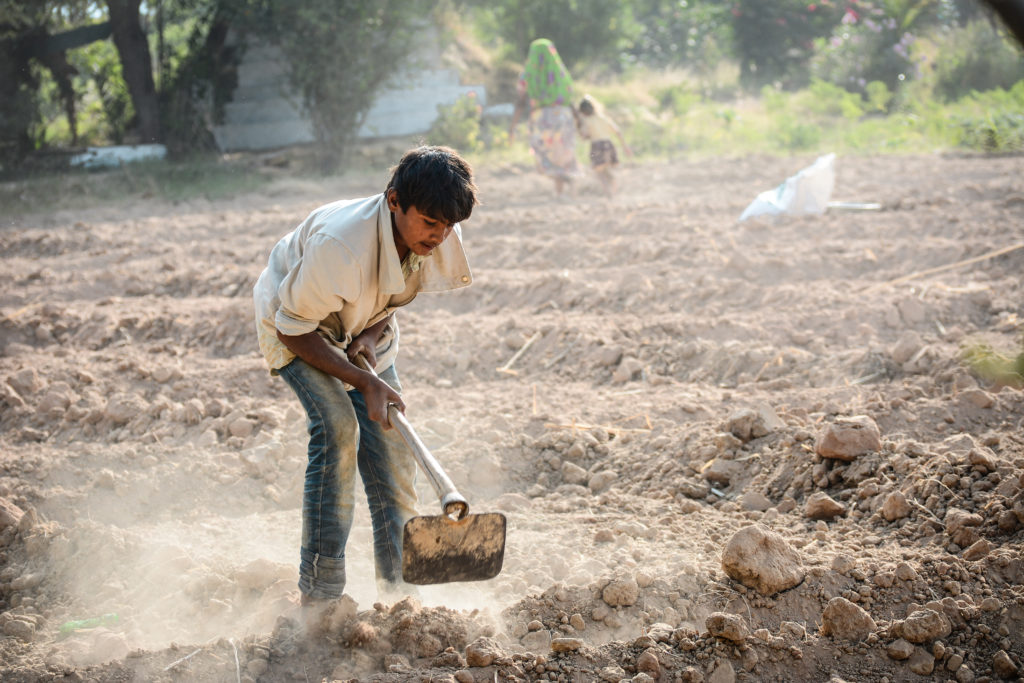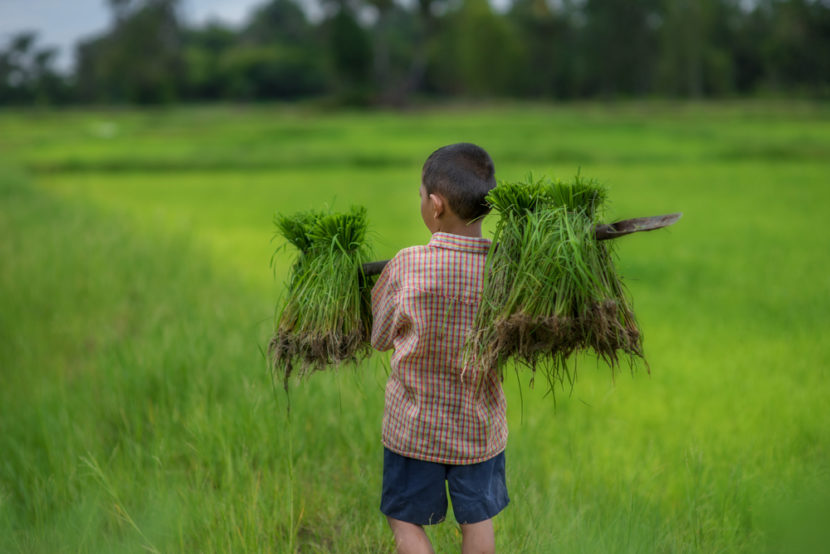Worldwide, the majority of child labour (70 percent) is found in the agriculture sector (FAO, 2023). More specifically, today 112 million boys and girls are engaged in child labour in crop production, livestock, forestry, fisheries or aquaculture, which often involves working long hours and hazardous conditions. While many of the challenges can be traced back to root causes like poverty, sociocultural factors and lack of awareness about this issue, these root causes are complex and require all available resources from governments, civil society and the private sector to tackle child labour in agriculture.
Child workers in the agricultural sector
Estimates suggest that 160 million children around the world, or 1 in 10 of all children, are involved in some form of child labour in general. The impacts of the COVID-19 pandemic, conflicts and climate change are promoting the rise of these numbers. In fact, the number of children involved could rise by almost 9 million by the end of 2023 – marking the first increase in two decades (End Violence, 2023).
In particular, agriculture is the sector responsible for the largest amount of child labour worldwide. According to the Food and Agriculture Organization of the United Nations (FAO), more than 112 million children work in agriculture, including in farming, fishing, aquaculture, forestry and livestock. This accounts for approximately 70 percent of child labourers in the world (FAO, 2023).
Child labour in agriculture is often invisible as most children work as unpaid family workers in dispersed small-scale farms or rural enterprises or is actively hidden by employers, facilitated by the limited reach of labour inspectors in rural areas (FAO, 2020).
Data available on girls’ and boys’ labour in agriculture are limited and not captured by conventional surveys as children in a situation of child labour are often referred to as “helpers” assisting the parents on the family farm, on fishing boats, in plantations, in mountain areas, herding livestock – although they may do similar work to adults and the tasks are equally strenuous. Furthermore, most national surveys still do not take into account domestic chores, failing to capture the children’s “double-burden”, more often shouldered by girls (FAO, 2020).
Hazardous work lacking adequate protection
Agriculture is one of the three most dangerous sectors in terms of work-related fatalities, non-fatal accidents and occupational diseases. In fact, children may be exposed to a number of hazardous situations because of their young age, and made to carry heavy loads, be exposed to chemicals and sharp tools that can lead to fatalities and serious health consequences (INTPA, 2021).
Children working in agriculture may have to use heavy machinery or sharp tools, be exposed to pesticides or harmful insects, and work for long hours and in extreme weather conditions. They could suffer from physical injuries, respiratory problems connected to the chemicals and pesticides they could inhale and also skin infections, given the substances they enter in contact with (InfoStories, 2023).
Root causes of child labour in agriculture

Child labour in the agricultural sector is a huge phenomenon which affects children all over the world. One of the main features of this issue is the fact that it is the result of many root causes that are intertwined.
Poverty
Poverty is widely accepted to be one of the root causes of child labour. It also remains one of the most obstinate barriers to education and denies children their basic needs such as food, clean drinking water and health services (Gaffar, Kämpfer, 2023).
Regardless of the sector or the country in which the research took place, statistics from manufacturing, agriculture and mining industries in eight countries (Ethiopia, Brazil, India, Indonesia, Sri Lanka, Vietnam, Turkey and the Democratic Republic of Congo) between 2019 and 2021, shows that many workers, farmers and miners alike do not earn enough to pull their families out of poverty. In fact, they earn so little that they struggle to pay for basic expenses such as food and education. As a result, low incomes directly pose a risk to children’s right to survival, protection, education and health (Gaffar, Kämpfer, 2023).
My father’s income was insufficient to spend on the education of 4 children. So, I started to work at 14 so that my two younger brothers could attend school.
– A 17-year-old girl working in the garment sector in Sri Lanka in 2021 (End Violence, 2023)
Sociocultural factors
Cultural, social and demographic factors in rural areas are powerful drivers of child labour in agriculture. For instance, rural families may perceive the involvement of children in agriculture as part of their culture and a way of “helping out” and learning. There is also the case of children fostered with wealthier members of the extended family being expected to work in the fields and carry out domestic work in exchange for access to education or in order to give the opportunity for younger siblings to access education (FAO, 2020).
Moreover, caregivers or parents may not be aware of the harmful consequences of what constitutes hazardous work for their child. Many farmers do not realise that their children’s involvement in family farm work could be considered a form of child labour under certain conditions. In all agricultural settings, there is a general social acceptance of child work among parents. It can often be considered a coping mechanism in response to the economic need to get children involved in work early.
However, their awareness of how to protect their children from hazardous work may vary by location as well as the education level of parents (Gaffar, Kämpfer, 2023). Establishing space for dialogue and discussion at the local level is important to understand and value local knowledge, attitudes and practices, while raising awareness of harmful situations and promoting practical solutions (FAO, 2020).
Lack of access to education
Access to quality education in rural areas is key to keeping children out of child labour. Rural areas, however, are often characterised by a lack of or poor quality of schools and infrastructure, high turnover rates of teachers (especially in remote areas), limited pedagogical materials, curricula with little relevance for rural lives, poor and variable rates of rural school attendance, and lower levels of educational performance and achievement.
In addition, children may also have to walk long distances to and from school. Girls face further obstacles, such as traditional attitudes that do not value girls’ education. They also may face the risk of abuse during long commutes (ILO, 2023).
As mentioned before, low-income families could struggle to pay for the education of their children, especially if we consider the other costs related to education, such as school uniforms, books and transportation. Moreover, many schools have official classes for only half a day and may charge families extra for “tuition classes” to keep students in school longer.
All these costs, some of which are more invisible than others, account for a significant portion of family expenses and often exacerbate families’ struggles to afford these expenses (Gaffar, Kämpfer, 2023). This could push parents to send their children to work, especially in the agricultural sector where they could support their parents both in terms of practical support and from the economic point of view.
Recommendations for eradicating child agricultural work
While many of these challenges can be traced back to root causes like poverty, lack of knowledge and awareness and sociocultural factors, these root causes are complex and require all available resources from governments, civil society and the private sector to be tackled (Gaffar, Kämpfer, 2023). To do so, it is important to establish and reinforce partnerships and initiatives between governments and corporate actors, aligned with international conventions, standards, guidelines and national policies (INTPA, 2023).
Governments are on the front line in ending child labour in agriculture starting with strengthening social protection. By protecting households from extreme poverty, parents could refrain from sending their children to work for economic reasons and, in so doing, increase the chances for children to continue their educational path (OHCHR, 2022).
In terms of practical solutions, conditional cash transfers in education are also a good option to consider. They are a widely utilized social policy tool aiming at facilitating enrolment and regular attendance in education. In return for their children’s regular attendance at school, families receive a payment (Gaffar, Kämpfer, 2023).
On the other hand, it is crucial to implement social behaviour change communications on child labour elimination and raise awareness of the harmful effects of child labour (ILO, 2023). As mentioned before, the phenomenon of child workers in the agricultural sector is also driven by sociocultural factors so it is important to increase the visibility of children’s rights and to promote them at all levels of society. In this sense, promoting a space of dialogue and discussion at the local level to understand and value local knowledge, attitudes and practices on child labour in agriculture is essential (FAO, 2022).

We at Humanium are strongly engaged in promoting awareness of child protection in the agricultural sector. In Rwanda, we have facilitated the restoration of water pipes so the children who spent their time carrying water for their families could spend it in school instead. If you want to support our work, please consider joining Humanium by sponsoring a child, making a donation, or becoming a member or a volunteer!
Written by Arianna Braga
References:
End Violence (2023). From Food to Phones: Child Labour Risks are High in Global Supply Chains. Retrieved from End Violence at https://www.end-violence.org/articles/food-phones-child-labour-risks-are-high-global-supply-chains, accessed on 1 August 2023.
FAO (2020). FAO framework on ending child labour in agriculture. Retrieved from FAO at https://www.fao.org/documents/card/en/c/ca9502en/, accessed on 5 August 2023.
FAO (2023). Child Labour in Agriculture. Retrieved from FAO at https://www.fao.org/childlabouragriculture/en/?amp%3Butm_campaign=buffer, accessed on 1 August 2023.
Gaffar, C., Kämpfer, I. (2023). Child Rights Risks in Global Supply Chains: Why a ‘Zero Tolerance’ Approach is not Enough. Retrieved form Save the Children at https://resourcecentre.savethechildren.net/pdf/save-the-children-child-rights-risks-in-global-supply-chains-2023.pdf/, accessed on 31 July 2023.
ILO (2023). Education and child labour in agriculture. Retrieved from ILO at https://www.ilo.org/ipec/areas/Agriculture/WCMS_172347/lang–en/index.htm, accessed on 7 August 2023.
InfoStories (2023). Child labour in agriculture. Retrieved from ILO at https://www.ilo.org/infostories/en-GB/Stories/Child-Labour/Child-Labour-In-Agriculture#introduction, accessed on 5 August 2023.
INTPA (2023). To eradicate child labour we must focus our attention on agriculture. Retrieved from INTPA at https://international-partnerships.ec.europa.eu/news-and-events/stories/eradicate-child-labour-we-must-focus-our-attention-agriculture_en, accessed on 7 August 2023.
OHCHR (2022). UN experts urge action to address alarming increase of child labour in agriculture sector. Retrieved from OHCHR at https://www.ohchr.org/en/press-releases/2022/05/un-experts-urge-action-address-alarming-increase-child-labour-agriculture, accessed on 7 August 2023.


